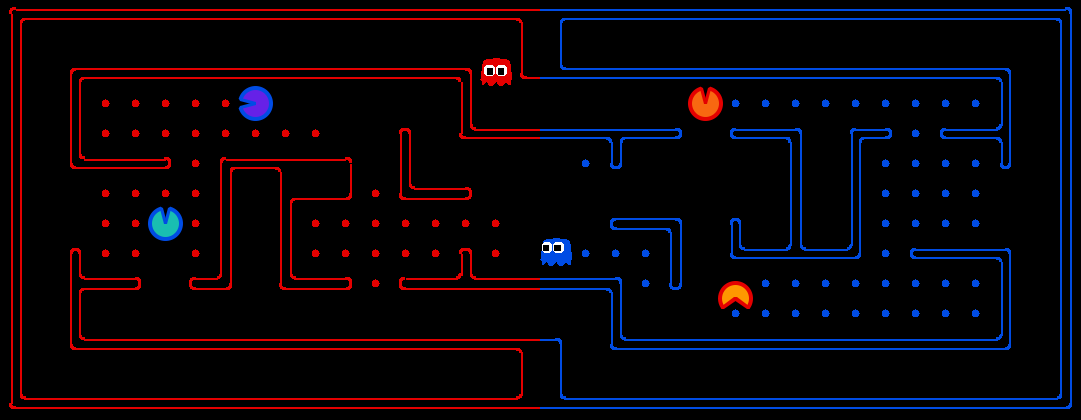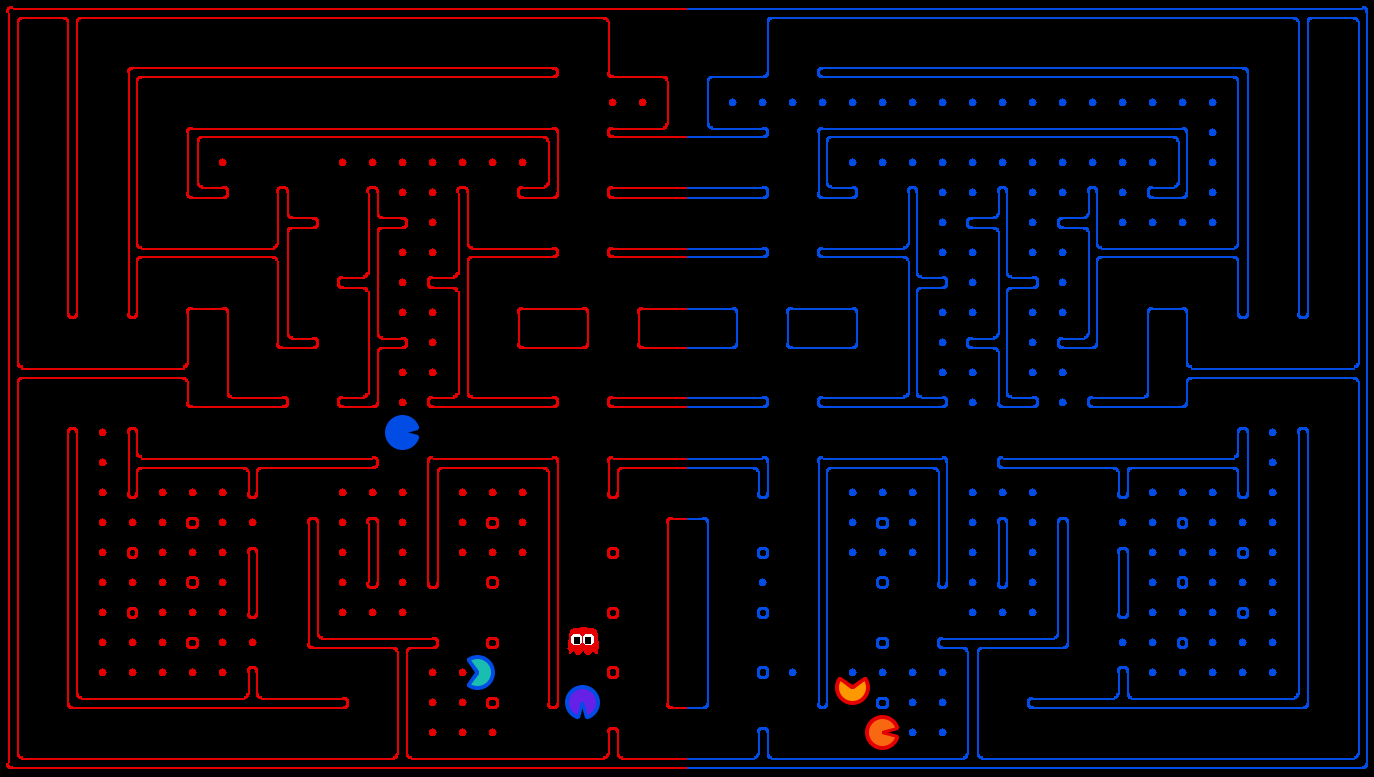
Onto enemy terrain.
Capture all their food!
We also thank Daniel Urieli for the initial adaptation of this assignment for the CS343 Artificial Intelligence course at The University of Texas at Austin.

Enough of defense,
Onto enemy terrain.
Capture all their food!
The course contest involves a multi-player capture-the-flag variant of Pacman, where agents control both Pacman and ghosts in coordinated team-based strategies. Your team will try to eat the food on the far side of the map, while defending the food on your home side. The contest code is available as a zip archive.
| Key files to read: | |
capture.py |
The main file that runs games locally. This file also describes the new capture the flag GameState type and rules. |
pacclient.py |
The main file that runs games over the network. |
captureAgents.py |
Specification and helper methods for capture agents. |
| Supporting files: | |
game.py |
The logic behind how the Pacman world works. This file describes several supporting types like AgentState, Agent, Direction, and Grid. |
util.py |
Useful data structures for implementing search algorithms. |
distanceCalculator.py |
Computes shortest paths between all maze positions. |
graphicsDisplay.py |
Graphics for Pacman |
graphicsUtils.py |
Support for Pacman graphics |
textDisplay.py |
ASCII graphics for Pacman |
keyboardAgents.py |
Keyboard interfaces to control Pacman |
layout.py |
Code for reading layout files and storing their contents |
Academic Dishonesty: As usual, we expect you not to falsely represent your work. Please don't let us down.
Scoring: When a Pacman eats a food dot, the food is permanently removed and one point is scored for that Pacman's team. Red team scores are positive, while Blue team scores are negative.
Eating Pacman: When a Pacman is eaten by an opposing ghost, the Pacman returns to its starting position (as a ghost). No points are awarded for eating an opponent. Ghosts may be able to eaten -- so maps contain power pellets, others do not.
Winning: A game ends when one team eats all but two of the opponents' dots. Games are also limited to 3000 agent moves. If this move limit is reached, whichever team has eaten the most food wins.
Computation Time: Each agent has 1 second to return each
action. Each move which does not return within one second will incur a
warning. After three warnings, or any single move taking more than 3
seconds, the game is forfeit. There will be an initial start-up
allowance of 15 seconds (use the registerInitialState function).
Observations: Agents can only observe an opponent's configuration (position and direction) if they or their teammate is within 5 squares (Manhattan distance). In addition, an agent always gets a noisy distance reading for each agent on the board, which can be used to approximately locate unobserved opponents.
config.py with your team name, agents, and other options. Make a zip archive named contest.zip, containing this and the rest of your files (no subdirectories within the zip file please). If you are working with another student please register your group on Canvas. Then turn in your code under the "Contest" assignment on Canvas.
For your reference, we have provided a sample config.py configured for the BaselineAgent. The BaselineAgent directory itself is inside the teams directory. Make sure to pick a unique team name!
BaselineAgents that the staff has provided:
python capture.py
A wealth of options are available to you:
python capture.py --helpThe --frameTime option can be useful for controlling the speed of the displayed game. There are six slots for agents, where agents 0, 2 and 4 are always on the red team and 1, 3 and 5 on the blue team. Agents are created by agent factories (one for Red, one for Blue). See the section on designing agents for a description of the agents invoked above. The only agents available now are the
BaselineAgents. They are chosen by default, but as an example of how to choose teams:
python capture.py -r BaselineAgents -b BaselineAgentswhich specifies that the red team
-r and the blue team -b are BaselineAgents.
To control an agent with the keyboard, pass the appropriate option to the red team:
python capture.py --redOpts first=keysThe arrow keys control your character, which will change from ghost to Pacman when crossing the center line.
Local games (described above) allow you to test your agents against the baseline teams we provide and are intended for use in development.
config.py and then submit under the assignment name cs343-contest.
Be sure to pick a unique name for your team. Tournaments are run
everyday at midnight and include all teams that have been submitted
(either earlier in the day or on a previous day) as of the start of the
tournament. Currently, each team plays every other team in a best-of-3
match, but this may change later in the semester. The results are updated on the website after the tournament completes each night.
Baseline Agents: To kickstart your agent design, we have provided you with two baseline agents. They are both quite bad.
The OffensiveReflexAgent moves toward the closest food on the opposing side. The DefensiveReflexAgent wanders around on its own side and tries to chase down invaders it happens to see.
Directory Structure: You should place your agent code in a new sub-directory of the teams directory. You will need a config.py file, which specifies your team name, authors, agent factory class, and agent options. See the BaselineAgents example for details.
Interface: The GameState in capture.py should look familiar, but contains new methods like getRedFood,
which gets a grid of food on the red side (note that the grid is the
size of the board, but is only true for cells on the red side with
food). Also, note that you can list a team's indices with getRedTeamIndices, or test membership with isOnRedTeam.
Finally, you can access the list of noisy distance observations via getAgentDistances.
These distances are within 6 of the truth, and the noise is chosen
uniformly at random from the range [-6, 6] (e.g., if the true distance
is 6, then each of {0, 1, ..., 12} is chosen with probability 1/13).
You can get the likelihood of a noisy reading using getDistanceProb.
Distance Calculation: To facilitate agent development, we provide code in distanceCalculator.py to supply shortest path maze distances.
To get started designing your own agent, we recommend subclassing the CaptureAgent class. This provides access to several convenience methods. Some useful methods are:
def getFood(self, gameState):
"""
Returns the food you're meant to eat. This is in the form
of a matrix where m[x][y]=true if there is food you can
eat (based on your team) in that square.
"""
def getFoodYouAreDefending(self, gameState):
"""
Returns the food you're meant to protect (i.e., that your
opponent is supposed to eat). This is in the form of a
matrix where m[x][y]=true if there is food at (x,y) that
your opponent can eat.
"""
def getOpponents(self, gameState):
"""
Returns agent indices of your opponents. This is the list
of the numbers of the agents (e.g., red might be "1,3,5")
"""
def getTeam(self, gameState):
"""
Returns agent indices of your team. This is the list of
the numbers of the agents (e.g., red might be "1,3,5")
"""
def getScore(self, gameState):
"""
Returns how much you are beating the other team by in the
form of a number that is the difference between your score
and the opponents score. This number is negative if you're
losing.
"""
def getMazeDistance(self, pos1, pos2):
"""
Returns the distance between two points; These are calculated using the provided
distancer object.
If distancer.getMazeDistances() has been called, then maze distances are available.
Otherwise, this just returns Manhattan distance.
"""
def getPreviousObservation(self):
"""
Returns the GameState object corresponding to the last
state this agent saw (the observed state of the game last
time this agent moved - this may not include all of your
opponent's agent locations exactly).
"""
def getCurrentObservation(self):
"""
Returns the GameState object corresponding this agent's
current observation (the observed state of the game - this
may not include all of your opponent's agent locations
exactly).
"""
Restrictions: You are free to design any agent you want. However, you will need to respect the provided APIs if you want to participate in the tournaments. Agents which compute during the opponent's turn will be disqualified. In fact, we do not recommend any sort of multi-threading.
The contest has two parts: a qualifying round and a final tournament.
Important dates (subject to change):
| Tuesday | 3/24 | Contest announced and posted |
| Tuesday | 3/31 | Qualification opens |
| Monday | 5/4 | Qualification closes (submit by 11:59pm) |
| Tuesday | 5/5 | Final tournament submission due (submit by 11:59pm) |
| Wednesday | 5/6 | Final tournament (time TBA) |
| Thursday | 5/7 | Awards ceremony in class |
Teams: You may work alone or in teams of 2 people using pair programming.
Prizes: The top three teams will receive awards in class (tentative) and extra credit points. All teams that qualify for the final tournament will receive full grade.

Have fun! Please bring our attention to any problems you discover.